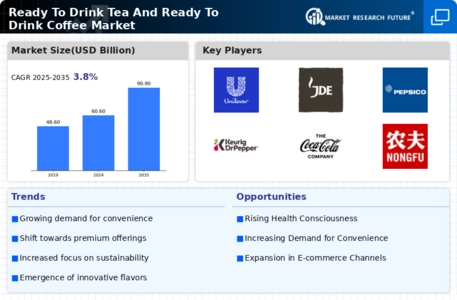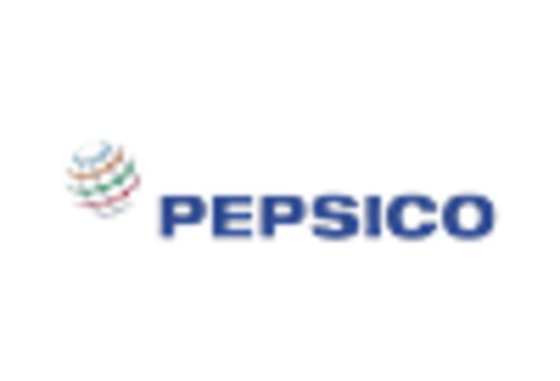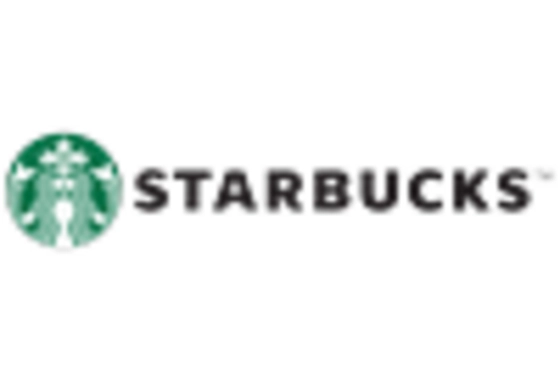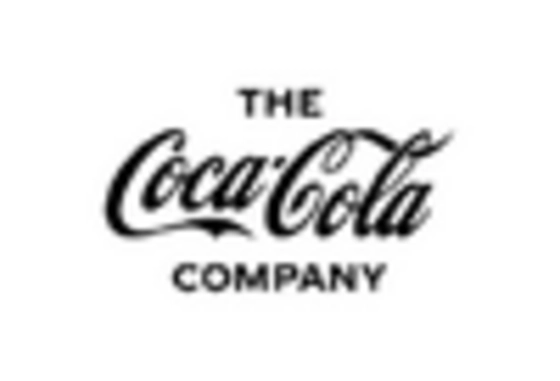The Ready To Drink Tea and Ready To Drink Coffee Market is currently characterized by a dynamic competitive landscape, driven by evolving consumer preferences and a growing demand for convenience. Major players such as The Coca-Cola Company (US), PepsiCo Inc (US), and Nestle S.A. (CH) are actively shaping the market through strategic initiatives focused on innovation, sustainability, and regional expansion. The Coca-Cola Company (US) has been particularly aggressive in diversifying its product portfolio, introducing new flavors and health-oriented options to cater to health-conscious consumers. Meanwhile, PepsiCo Inc (US) has been enhancing its distribution channels, leveraging partnerships to penetrate emerging markets more effectively. Nestle S.A. (CH) continues to emphasize its commitment to sustainability, integrating eco-friendly practices into its supply chain, which resonates well with environmentally aware consumers.
The business tactics employed by these companies reflect a moderately fragmented market structure, where localized manufacturing and supply chain optimization play crucial roles. Companies are increasingly localizing production to reduce costs and enhance responsiveness to regional tastes. This strategy not only improves operational efficiency but also allows for quicker adaptation to market changes. The collective influence of these key players fosters a competitive environment where innovation and sustainability are paramount, driving others to follow suit in order to maintain market relevance.
In August 2025, The Coca-Cola Company (US) announced the launch of a new line of organic ready-to-drink teas, aimed at capturing the growing segment of health-conscious consumers. This strategic move is significant as it aligns with the increasing consumer demand for organic products, potentially enhancing Coca-Cola's market share in the health-oriented beverage sector. The introduction of these products may also serve to differentiate Coca-Cola from competitors who have yet to fully embrace organic offerings.
In September 2025, PepsiCo Inc (US) revealed a partnership with a leading e-commerce platform to enhance its online sales of ready-to-drink coffee products. This initiative is indicative of the company's recognition of the shifting retail landscape towards digital channels. By strengthening its online presence, PepsiCo aims to tap into the growing trend of online grocery shopping, thereby expanding its reach and accessibility to consumers who prefer the convenience of home delivery.
In July 2025, Nestle S.A. (CH) unveiled a new sustainability initiative focused on reducing plastic waste in its ready-to-drink coffee packaging. This initiative is crucial as it not only addresses consumer concerns regarding environmental impact but also positions Nestle as a leader in sustainable practices within the beverage industry. By prioritizing eco-friendly packaging solutions, Nestle is likely to enhance its brand loyalty among environmentally conscious consumers, thereby solidifying its competitive edge.
As of October 2025, the competitive trends in the Ready To Drink Tea and Ready To Drink Coffee Market are increasingly defined by digitalization, sustainability, and the integration of advanced technologies such as AI. Strategic alliances are becoming more prevalent, as companies recognize the need to collaborate in order to innovate and meet consumer demands effectively. Looking ahead, it appears that competitive differentiation will evolve from traditional price-based competition to a focus on innovation, technological advancements, and supply chain reliability, as companies strive to create unique value propositions that resonate with consumers.

















Leave a Comment